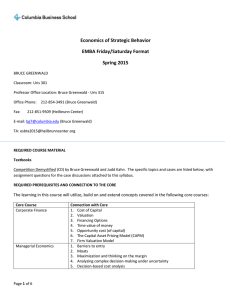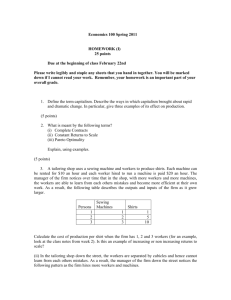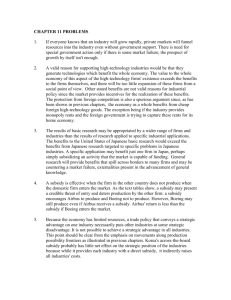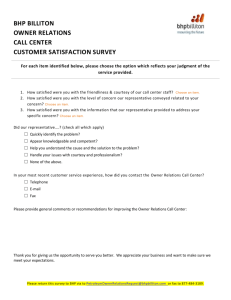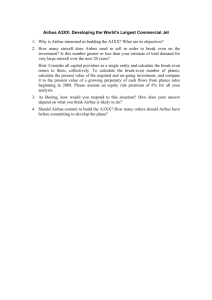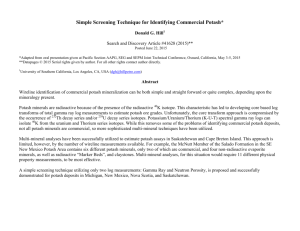Syllabus
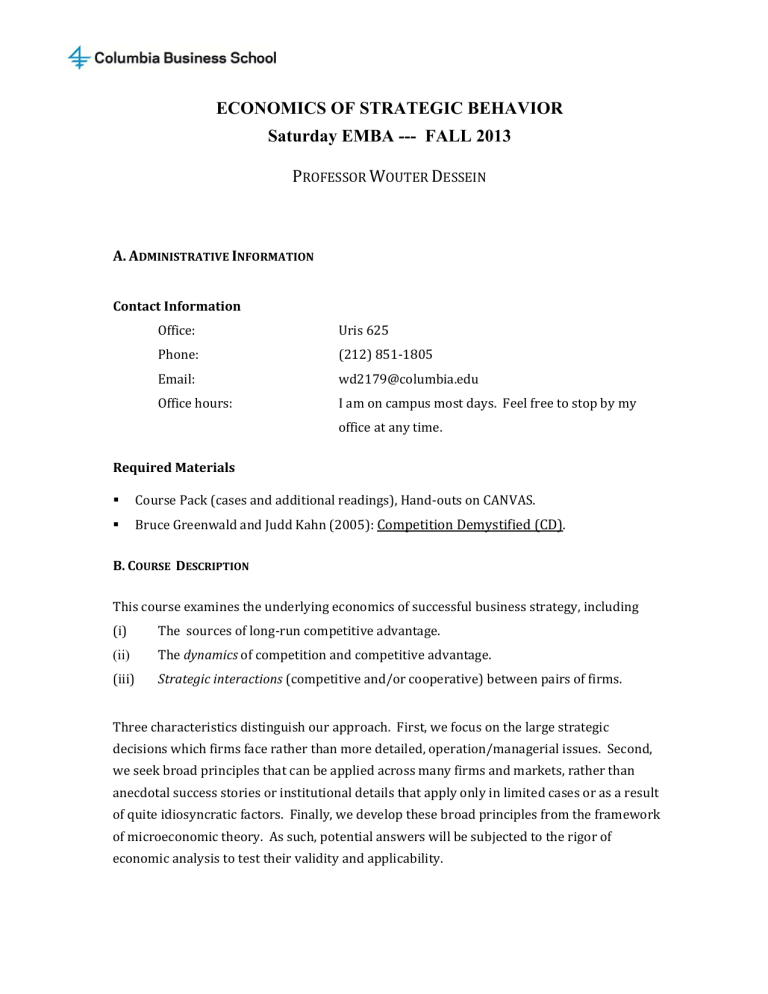
ECONOMICS OF STRATEGIC BEHAVIOR
Saturday EMBA --- FALL 2013
P ROFESSOR W OUTER D ESSEIN
A.
A
DMINISTRATIVE
I
NFORMATION
Contact Information
Office:
Phone:
Email:
Office hours:
Uris 625
(212) 851‐1805 wd2179@columbia.edu
I am on campus most days. Feel free to stop by my office at any time.
Required Materials
Course Pack (cases and additional readings), Hand‐outs on CANVAS.
Bruce Greenwald and Judd Kahn (2005):
Competition Demystified (CD)
.
B.
C OURSE D ESCRIPTION
This course examines the underlying economics of successful business strategy, including
(i) The sources of long‐run competitive advantage.
(ii)
The dynamics of competition and competitive advantage.
(iii) Strategic interactions (competitive and/or cooperative) between pairs of firms.
Three characteristics distinguish our approach. First, we focus on the large strategic decisions which firms face rather than more detailed, operation/managerial issues. Second, we seek broad principles that can be applied across many firms and markets, rather than anecdotal success stories or institutional details that apply only in limited cases or as a result of quite idiosyncratic factors. Finally, we develop these broad principles from the framework of microeconomic theory. As such, potential answers will be subjected to the rigor of economic analysis to test their validity and applicability.
The approach toward teaching and learning is primarily inductive. That is, you will learn the concepts and principles outlined above largely through examples – this is the essence of the case study method. The goal is to carefully study specific business situations and decisions with the goal of extracting broader principles about business strategy, which will then be available to you in a wide variety of managerial contexts. Course time will be split roughly
65/35 between case discussions and lectures.
Good cases are necessarily complex and ambiguous. In preparing for case discussions, you may find sorting through this complexity and ambiguity to be frustrating. The problems presented in the case discussion may not have one correct answer. However, there will generally be a set of insights and solutions that are better than others. And it is in working through the messy details to find these insights and solutions – both in your own preparation and in class discussion – that the concepts and principles introduced in the readings and lectures will come alive and be enriched for you.
C.
R
EQUIRED
P
REREQUISTIES AND
C
ONNECTION TO THE CORE
.
The learning in this course will utilize, build on and extend concepts covered in the following core courses:
Core Course
Managerial
Strategy
Economics
Formulation
Connection with Core
1.
Understanding market competition and equilibrium thinking (in the short ‐ run).
2.
Market equilibrium thinking (in the long ‐ run) and barriers to entry.
3.
Strategic Interaction among firms and Nash Equilibrium.
4.
Pricing with market power.
1.
Creation of value vs.
value capture
2.
Competing firms.
Students will be expected to have mastered these concepts and be able to apply them in the course
D.
C
LASS
S
CHEDULE
I.
Sources and Dynamics of Competitive Advantage .
The first part of the course is focused on understanding the sources and dynamics of competitive advantages. It presents a simplified approach to business strategy, based on the notion that any long ‐ run competitive advantage must rely on “barriers to entry”. Firms without competitive advantages should concentrate all their efforts on being efficient. Firms that do have competitive advantages need to design strategy with their competitors in mind:
Session
Session
Sept
Session
Oct
Session
Oct
28
12
19
Session 1
Sept 7
Session 2
Sept 21
3
4
5
Topic
Intro to Competitive
Strategy.
Sources of Competitive
Advantage.
Sources of Competitive advantage
Guest speaker:
Booz &Co Partner
Firm Scope and
Competitive advantage;
Dynamics
Advantage
& Two ‐ of
sided
Competitive markets
Cases
Other
Reading
Assignments
Enterprise Rent ‐ A ‐ Car*
Competition Demystified (CD)
Chapters 1 ‐ 3
Airborne Express*
The Economist*
CD Chapters 5 ‐ 6
Capital One*
“ Chapter 3: Two main routes to Competitive
Advantage” (Course Pack)
Disney and Pixar
Microsoft in Search* ;
E ‐ harmony*
CD Chapter 7
II.
Shared Competitive Advantages: Managing Strategic Interactions .
After having developed the basic tools for the analysis of competitive advantage, we will use game theory as a framework for analyzing “shared competitive advantages”. The basic issue is simply this – when competitive advantage is shared with other firms, any action I take will elicit a reaction by my competitors. How can I incorporate those reactions in forming strategies so that I am not blindsided, and if possible, can even use them to my advantage?
Can I find away to move away from mutually destructive price competition, toward win‐win games? How do I enter an industry, or avoid entry by new competitors? How do I structure and manage my relationship with suppliers and complementors?
Section
½
(M
‐
W)
Session 6
Oct 26
Session 7
Nov 2
Session 8
Nov 9
Topic
Intro to Strategic
Interactions
Price Wars & Dynamics of Competition
Entry & Entry Deterrence
Strategies
Cases
Other
Reading
Assignments
Shrimp Game;
“Game Theory: How to make it Pay”
(Course Pack)
Philip Morris: Marlboro Friday;
Albert Heijn: Price Wars Among Retailers;
“The Dynamics of Price Competition”
(Course Pack)
Ready ‐ to ‐ Eat Breakfast Cereal;
Dogfight over Europe: Ryanair* ;
CD Chapters 11 ‐ 15
Airbus vs.
Boeing (A, B);
Power Play (A): Nintendo;
Session 9
Nov 16
Session 10
Nov 23
Dynamics of Competition;
Distributors, Suppliers and Complementors:
Friends or Foes?
Lecture on Co ‐ opetition;
Cap ‐ stone case on game theory in practice.
Strategic Economics &
Valuation
Session 11
Dec 7
Session 12 Open ‐ book Case ‐ based
Dec 14 Exam
E.
C
OURSE
R
EQUIREMENTS AND
G
RADING
2010 Potash Wars: BHP Billeton’s bid for
Potash Corporation of Saskatchewan.*
Magna case;
CD Chapter 16;
Grading will be based on class participation and on‐line case quizzes (35%), 3 case write‐ups
(25%), and an in‐class, open‐book case‐based exam (40%).
Class Participation and On
‐
line Quizzes (35%
‐
Individual/Type B)
For each case, there will be an online quizz , to be taken the day before class. Questions are multiple choice and/or require you to write a paragraph justifying your answer. Grading is based on the thoughtful completion of each of the quizzes. Be also prepared to discuss your answers in class.
Class participation is essential in order for you to get the maximum benefit from the course.
Your grade will be based on attendance, effort and the content of your contributions to the class discussions. The evaluation of content will be based on the following:
Relevance: Are your comments clearly related to the case and to the comments of others?
Do they move the discussion forward?
Fact‐Based: Have you used specific data from the case, from readings, or from personal experience to support the assertions that you are making?
Case discussion constitutes more than half the class time, so there will be ample opportunity for each of you to participate. If you feel that you are preparing well but that I am not calling on you enough, please let me know so that I can address the problem. In addition to voluntary participation, I often randomly select a few students to open and/or lead the case discussion .
Importantly, I ask that you deal with the cases as you find them; do not seek outside or post ‐ case data on the firm or industry . Of course, if you already know things about the case, from previous experience, this can be very useful in case discussions. Please let me know about it in advance, and I will make a point to call on you at the appropriate time.
Case Write
‐
ups (25% – Group/Type A)
Submit 3 case write‐ups, chosen from the starred (*) cases. Your case write‐up should focus on the study question(s) in bold face. Write ‐ ups can be submitted individually, or in groups of up to four.
Due date.
Day before the case is discussed in class, submitted online on CANVAS (Drop Box).
Format.
The write‐up should be no longer than 2 pages and consist of 3 parts: Your write‐up has to start with a one paragraph summary that states your basic position. The paragraph should be as concise as possible. Shorter is better. This is an exercise in synthesis. The rest of the write up essentially argues why that position is correct. At the end, you should list concisely 2 or 3 issues or potential problems with your position.
Use.
I may occasionally call upon someone or a group to discuss his or her ideas. I will not write comments on the case write‐ups, but will grade them as either “check‐minus”, “check”, or “check‐plus”.
In class, case
‐
based exam (40% – Individual/Type B)
This exam is open-book and takes place during session 12 of the class (during regular term).
Preparation Questions (be prepared to discuss these questions in class)
Case write
‐
ups (* cases) should focus on the questions in bold.
Enterprise Rent ‐ a ‐ Car (Case posted on CANVAS)
1.
How attractive is the car rental industry in terms of long‐term profitability?
2.
Analyze Enterprise’s strategy and competitive position. Why has Enterprise been so successful?
3.
Should Hertz or Avis launch a frontal assault on Enterprise?
Airborne Express*
1.
Why has the express mail industry been so difficult for smaller players?
2.
This is an industry with two major players. Why is competition between FedEx and UPS so fierce?
3.
How has Airborne managed to survive, and even thrive in this tough environment?
4.
Does Airborne have cost advantages?
Quantify if possible.
5.
What must Airborne do to continue to survive and thrive?
The Economist*
1.
What explains the success of The Economist thus far? Why has it managed to succeed while so many other magazines are struggling?
2.
What should Andrew Rashbass’ major priorities be going forward? What opportunities can the
Economist take advantage of, and what threats should they be sensitive to?
3.
Is Mass Intelligence a real business opportunity?
Capital One*
1.
What, if any, competitive advantages does Capital One have?
2.
Are these advantages sustainable into the future?
3.
As head of Capital One, what would be your strategic priorities?
Disney and Pixar
1.
Are Disney and Pixar better together?
2.
What are the alternatives to acquire Pixar. Is ownership really necessary? Or could another long-term contract do the trick?
3.
If you decide to acquire Pixar, how would you integrate the two companies? Where are the opportunities and the headaches, how would you handle them?”
Microsoft’s Search*
1.
What, if any, competitive advantages does Google enjoy in search. Are these competitive advantages sustainable?
2.
Does Microsoft have a competitive advantage in search?
What market share do they need to be profitable?
Do you think they will be successful?
3.
How should Google respond to Microsoft?
E ‐ Harmony*
1.
Why do people want to meet others on‐line instead of finding them in the real world?
2.
What are the barriers‐to‐entry in the online‐personals market?
3.
Does eHarmony have competitive advantages in this market?
What are they?
Do they result in higher profit ‐ margins per subscriber than Match.com
and Yahoo!?
4.
How serious is the competitive threat from Chemistry?
How should eHarmony respond?
Philip Morris: Marlboro Friday
1.
How would you describe Marlboro’s competitive position in early 1993?
2.
What is Marlboro’s marketing strategy at that time?
3.
How does this compare to RJ Reynolds’?
4.
What accounts for Philip Morris’ dramatic shift in strategy in April 1993? What are its goals?
5.
How should RJ Reynolds respond?
6.
What kind of industry future does Philip Morris anticipate?
Albert Heijn: Price Wars Among Retailers
1.
How would you describe Albert Heijn’s competitive position in 2003?
2.
What are the goals of Albert Heijn’s dramatic shift in strategy in October 2003?
3.
Will Albert Heijn be successful in achieving its goals? Is the new price strategy a smart move.
Ready ‐ to ‐ Eat Breakfast Cereal Industry*
1.
Why has RTE cereal been such a profitable business?
2.
How have the incumbent brands managed rivalry?
3.
And how has entry been avoided for such a long time?
4.
How should RTE cereal producers react to non‐branded entry?
Dogfight over Europe: Ryanair (A)*
1.
Describe Ryan Air’s entry strategy.
2.
Evaluate Ryan Air’s entry strategy.
Will it succeed?
3.
Place yourself in the shoes of the CEO of BA or AL. How would you respond to Ryan Air’s entry?
Airbus vs.
Boeing
1.
What competitive advantages, if any, does Boeing enjoy in the aircraft industry? What offsetting advantages does Airbus enjoy?
2.
What is Airbus’ entry strategy? How has Boeing responded? Are there alternative strategies you would recommend?
3.
How is the current competitive process likely to evolve?
4.
Is there an alternative evolution that you would like to see? As Boeing? As Airbus? As the
US and European governments? As the airlines?
Nintendo
1.
Nintendo successfully recreated the home video game business following the Atari‐era boom and bust. How did it do so?
2.
How did Nintendo capture value from the home video game business? How did it avoid that “content” developers (such as Electronic Arts), or distribution channels (such as
Wal‐Mart, ToysRUs) captured all the rents?
2010 Potash Wars*
1.
Why has the price of Potash been so volatile?
2.
How does the Canpotex cartel work, given that the cartel only controls a subset of the market capacity? What is the position of the Potash corporation in the cartel?
3.
Describe BHP’s strategic position in the potash market, before its takeover attempt. Is it weak? Strong? Why?
4.
Describe how a take ‐ over of PCS allows BHP to improve or exploit its pre ‐ takeover strategic position.
What would be other alternatives?
In what ways is a takeover better or worse than these alternatives from BHP’s perspective?
*
5.
Describe whether and how BHP’s strategy will increase value creation in the potash industry.
Describe whether and how it allows BHP to capture value in this industry.
Magna
1.
Is Magna a good investment in March, 2009 at $20/share?
2.
What problem do you foresee in such an investment?
